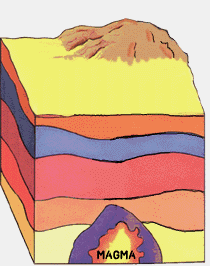CLASSIFICATION OF ROCKS
Igneous rocks (etymology from Latin ignis, fire) are rocks formed by solidification of cooled magma (molten rock), with or without crystallization, either below the surface as intrusive (plutonic) rocks or on the surface as extrusive (volcanic) rocks. This magma can be derived from partial melts of pre-existing rocks in either the Earth's mantle or crust. Typically, the melting is caused by one or more of the following processes — an increase in temperature, a decrease in pressure, or a change in composition. Over 700 types of igneous rocks have been described, most of them formed beneath the surface of the Earth's crust. These have diverse properties, depending on their composition and how they were formed.
Geologic significance
Igneous rocks make up approximately ninety-five percent of the upper part of the Earth's crust, but their great abundance is hidden on the Earth's surface by a relatively thin but widespread layer of sedimentary and metamorphic rocks.
Igneous rocks are geologically important because:
- their minerals and global chemistry give information about the composition of the mantle, from which some igneous rocks are extracted, and the temperature and pressure conditions that allowed this extraction, and/or of other pre-existing rock that melted.
- their absolute ages can be obtained from various forms of radiometric dating and thus can be compared to adjacent geological strata, allowing a time sequence of events.
- their features are usually characteristic of a specific tectonic environment, allowing tectonic reconstitutions (see plate tectonics).
Classification
Igneous rocks are classified according to mode of occurrence, texture, mineralogy, chemical composition, and the geometry of the igneous body.
In a simplified classification, igneous rock types are separated on the basis of the type of feldspar present, the presence or absence of quartz, and in rocks with no feldspar or quartz, the type of iron or magnesium minerals present. Rocks containing quartz (silica in composition) are silica-oversaturated. Rocks with feldspathoids are silica-undersaturated, because feldspathoids cannot coexist in a stable association with quartz.
Igneous rocks which have crystals large enough to be seen by the naked eye are called phaneritic; those with crystals too small to be seen are called aphanitic. Generally speaking, phaneritic implies an intrusive origin; aphanitic an extrusive one.
An igneous rock with larger, clearly discernible crystals embedded in a finer-grained matrix is termed porphyry. Porphyritic texture develops when some of the crystals grow to considerable size before the main mass of the magma crystallizes as finer-grained, uniform material.
Intrusive igneous rocks
Intrusive igneous rocks are formed from magma that cools and solidifies within the earth. Surrounded by pre-existing rock (called country rock), the magma cools slowly, and as a result these rocks are coarse grained. The mineral grains in such rocks can generally be identified with the naked eye. Intrusive rocks can also be classified according to the shape and size of the intrusive body and its relation to the other formations into which it intrudes. Typical intrusive formations are batholiths, stocks, laccoliths, sills and dikes. The extrusive
rocks often produce lava flows.
 |
| Granite |
Extrusive igneous rocks
Extrusive igneous rocks are formed at the Earth's surface as a result of the partial melting of rocks within the mantle and crust.
The melt, with or without suspended crystals and gas bubbles, is called magma. Magma rises because it is less dense than the rock from which it was created. When it reaches the surface, magma extruded onto the surface either beneath water or air, is called lava. Eruptions of volcanoes into air are termed subaerial whereas those occurring underneath the ocean are termed submarine. Black smokers and mid-ocean ridge basalt are examples of submarine volcanic activity.
The volume of extrusive rock erupted annually by volcanoes varies with plate tectonic setting. Extrusive rock is produced in the following proportions:
- divergent boundary: 73%
- convergent boundary (subduction zone): 15%
- hotspot: 12%
 |
| Basalt |
Uses:
- Granite is used for long lasting monuments and for trim and decoration on buildings. Granite looks attractive when polished and is often used for the facades(fronts) of buildings, expensive kitchen worktops and gravestones.
- Pumice is actually a kind of glass and not a mixture of minerals. Because this rock is so light, it is used quite often as a decorative landscape stone. Ground to a powder, it is used as an abrasive in polish compounds and in Lava© soap.
- Basalt can be rich source of iron and is commonly used as an aggregate in the building of roads.
- Gabbro can be polished to a brilliant black luster and can be used to make cemetery markers, kitchen counter tops, floor tiles, facing stone and other dimension stone products.
- Pegmatite rock has limited use as an architectural stone. However, pegmatite deposits often contain gemstones, industrial minerals and rare minerals.
.gif)

No comments:
Post a Comment